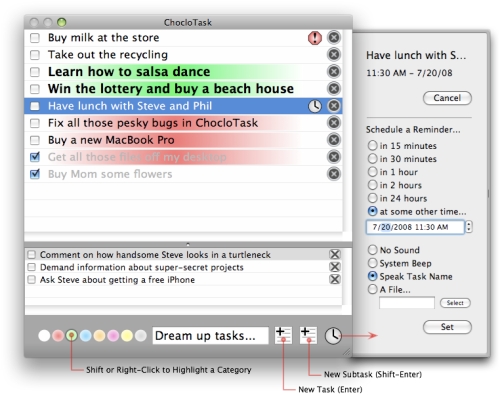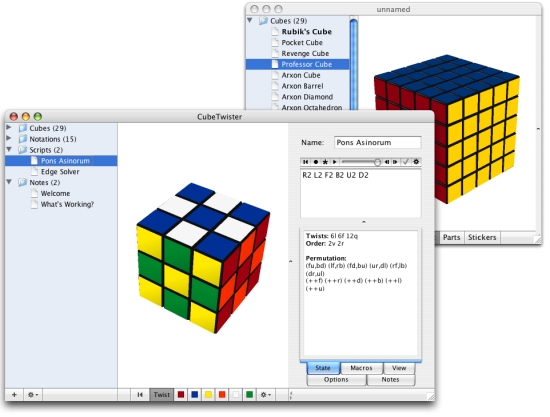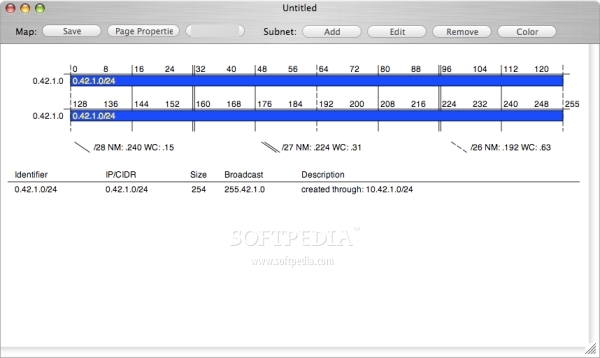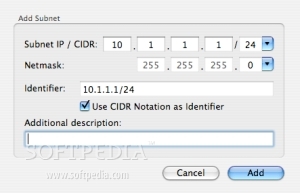If you're a regular Softpedia user and Mac head, you probably noticed we skipped a week with our usual Mac Apps of the Week. Don't worry, we included the cool stuff we found last week in today's piece. As usual, every piece of software detailed below is free to download, install and use.
ChocloTask
Currently at its first public release, ChocloTask is just another task manager, but just as developer ChocloSoft puts it... "Stop complaining, it's free!" For those who can't get enough free organizing tools, ChocloTask is probably the easiest reminder tool for Mac OS X users since it doesn't clog up your view with an actual calendar. You simply check the boxes on and off, setting reminders on a per-task basis That's it!
As a Mac app, ChocloTask would have probably done a better job, had it been able to sync with iCal. On the one hand, ChocloSoft notes, an "arguably" more sophisticated system is available within this app, to manage tasks. Those are the subtasks. ChocloSoft provides a comprehensive (and rather funny) example of what its free organizing tool does:

Since you probably got the idea already, here's where ChocloTask will come in most handy:
- rearrange and assemble a list of tasks any way you want - assign a list of subtasks to every task - color-code your tasks and set a reminder for each - beep, play music, or even read the task name out loud! - if you really need to focus on something else, you can set ChocloTask to an opaque background window - promote tasks for which a reminder has fired, or demote tasks which you have marked as completed, all automatically - use the dock to notify you of reminders.
ChocloTask uses the Sparkleframework, which allows it to update itself whenever a new version is made available. You will, of course, be prompted to accept or decline the update.
There are other alternatives to ChocloTask, in case you were looking for a different organizing tool. Although ChocloTask "aims to scratch an itch that none of the other applications quite reach," it may turn out that the program isn't what you need, so you could also look into these similar products: Anxiety (Free), Check Off (Free), Dejumble ($19), TaskPaper ($18.95), Things ($39) or Today ($15). A lot of task management applications that already exist for the Mac do their bit, but not everybody has the same habits, or tasks to accomplish, so naturally, you have to have diversity in the tools as well.
ChocloTask is available HERE as a free download. This Leopard-only app is a Universal Binary - good for PPC and Intel-based machines.
CubeTwister
CubeTwister is your companion to your Rubik's Cube, which uses a highly-configurable editor for cube scripts / maneuvers. The application is suitable for beginners, cube lovers, speed-cubers and mathematicians alike, who can use it as a tool to solve scrambled cube situations, to document their collection of cubes, describe solution algorithms and show off to fellow mathematicians, or simply analyze the permutations of cube parts.
CubeTwister provides Accurate 3D models of Rubik's Cube 3x3, Pocket Cube 5x5, Barrel Cube, Diamond Cube, Pocket Cube 2x2, Revenge Cube 4x4, and Octahedron Cube. All models can have individual color schemes and can even be disassembled. You can edit the models to reflect your personal collection of cubes, but you can also use the configurable parser which supports quarter-turn twists, half-turn-twists, rotations, permutations, inversions, reflections, repetitions, conjugations, commutations, and macros. You can define your own notation, and you can translate between notations. Using CubeTwister's database for scripts, maneuvers and patterns, you can organize Cubes, Notations, Scripts and Texts in a tree structure. The documents are saved in XML format and can be edited using other XML tools. You can enter all your scripts and supportive documentation too.
?The Kociemba Two-Phase Solver (derived from Greg Schmidt's KCube program) generates scripts which are only two or three twists longer than the optimal solution. Users enter an arbitrary state of the cube and let it solve. Using the solver you can also optimize your scripts and ultimately publish your scripts on the web for everyone to see your genius. HTML pages with interactive Java applets can be created for each cube design and cube script, while QuickTime movies and video still images can be created (exported) from the very same scripts.

Developer Werner Randelshofer says any OS is supported, including (but not limited to) Mac OS X, Linux, Solaris, Unix and Windows. On some operating systems (especially Windows) you have to install a Java 2 Runtime Environment 1.5 (or higher) before you can install CubeTwister. The rest of the requirements call for 512 MB of RAM and 30 MB of free disk space.
Installing CubeTwister
Binary edition Mac OS X
1- Download the CubeTwister disk image for Mac OS X 2- Open the disk image and drag the CubeTwister folder to your hard disk. 3- Doubleclick the CubeTwister icon to start the program. 4- Install Java 1.3.1 or later on your compute 5- Download the Install Anywhere Installer for your operating system from http://www.randelshofer.ch/cubetwister/download.html 6- Start the installer and follow the (lengthy) instructions. 7- Doubleclick the CubeTwister icon to start the program.
CubeTwister is free. Documents created with CubeTwister are not subject to license fees. All rights stay with the author or third party copyright holder of the contents of the document. However, you may only use the software for personal / non-commercial reasons.
NOTE: Some known issues include a defunct searching in the help viewer. Users are encouraged to report any bug they may encounter.
Click HERE to download CubeTwister (Mac OS X 10.4 or later, Universal Binary).
SubnetMapper
As a network administrator, you need to keep track of managed IP networks, free ranges that are available for assigning and documenting a network setup, and more. Thomas Thiel has come up with a free and easy solution to this, called SubnetMapper. The software is aimed at admins looking to manage and document small to medium networks. It can prints and display little maps of a network. The maps are colourable, just like in the good ol' cisco days, the developer notes.
Just to clear any possible misunderstanding right from the start, SubnetMapper runs solely on Mac OS X and there is no port available or planned. So, here's how it works:

The screenshot above represents the default document window of SubnetMapper. You can have multiple maps open at once, according to Thomas. By clicking on a subnet (its rectangular representation on the map) it will be selected and its border will appear red. To deselect a subnet just click anywhere on the map, either selecting another subnet or deselecting all subnets. From this point forth, you can use the following functions:
Save: save your map to a file - you can open it using the standard methods like doubleclicking on a saved file or using the open file menu item.
Page Properties: set the page properties for printouts.
Print: print out the map.
Add: add a new subnet - it will open a new dialog which will be documented farther down in this document.
Remove: remove the selected subnet - you can select a subnet by simply clicking on its rectangular representation.
Edit: edit the selected subnet - you can select a subnet by simply clicking on its rectangular representation on the map.
Color: change the color of the selected and following subnets.

This is the dialog box enabling you to add a new subnet. You can enter the IP address of your net here and specify either CIDR or the classic subnet notation. The dialog itself will make sure both input values will be in sync after editing of either value. By checking the checkbox you can use a default identifier for your new subnet which will be the subnet address you have entered in CIDR notation. The Identifier of a subnet is the data which is rendered into the rectangle on the map. The description field will be shown in the listing beneath the map.
Thomas says he would be happy to answer any questions regarding SubnetMapper, or listen to suggestions from other admins, so fell free to contact the guy here: [email protected]
SubnetMapper is free and available under the GPLv2. You are entitled to distribute and manipulate the software, but remember to credit and notify the developer.
Download SubnetMapper for free HERE.
See you next week.

 14 DAY TRIAL //
14 DAY TRIAL // 

